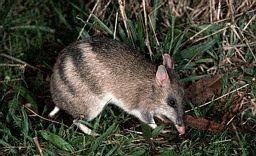Rank Species | Higher classification Perameles | |
 | ||
Similar Lesser bilby, Mammal, Broad‑faced potoroo, Crescent nail‑tail wallaby, Perameles | ||
The desert bandicoot (Perameles eremiana) is an extinct bandicoot of the arid country in the centre of Australia. The last known specimen was collected in 1943 on the Canning Stock Route in Western Australia. It is presumed to be Extinct.
It was about 180–285 mm (7.1–11.2 in) long, with a tail of around 100 mm (3.9 in), with long, semi-pointed ears, noticeably hairy soles on the hind feet, and (at least in some areas) a dull orange colour on the sides and back rather than the usual bandicoot brown. Its diet is not known with certainty, but has been reported to include ants, beetle larvae, and termites.
Their first specimens, from the Alice Springs area, were described in 1897. It appears to have been common in the remote north-west of South Australia, the south-west of the Northern Territory, and the central part of Western Australia at least until the 1930s. Unconfirmed reports suggest that its range may have extended to the Tanami Desert and the arid Western Australian coast between Broome and Port Hedland.
Favoured habitat was sandy desert with spinifex and other tussock grasses. It appears to have disappeared between about 1943 and 1960. While the cause of its decline remains uncertain, it is thought to be related to the changed burning regimes that followed the removal of Aboriginal people from the central Australian deserts. Another factor may have been the arrival of the introduced red fox.
